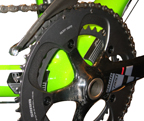
Figure 1:
Carbon frame shields
Trek bicycle frames are constructed from a variety of high performance materials. For safe operation and long life, take care of your bicycle frame by following these instructions. Read the Warning About Mechanical Work before performing any service work on your bicycle.
Before every ride carefully inspect your frame for signs of fatigue. If any frame part shows signs of damage or fatigue, consult your dealer or replace the frame before riding the bicycle.
Many bicycles that are made of carbon fiber composite have metal shields near the bottom bracket to protect the frame in case of the chain dropping off (Figure 1). Make sure the shields on your frame are intact, in position, and solidly attached. If they are not, take the bicycle to your dealer and have new shields installed.
If your bicycle frame has any carbon fiber parts, also follow the carbon fiber composite inspection procedures.
|
|
Figure 1: Carbon frame shields |
Once a month check that the attachment bolts of your adjustable dropouts are tightened to the torque specifications.
If your frame has adjustable rear dropouts, once a month check that the bolts are tightened according to the adjustment instructions.
The aluminum, titanium, or carbon fiber composite parts of your bicycle, both frame tubes and parts like rockers or dropouts, are not as ductile as steel. If you attempt to modify, bend, or twist an aluminum or carbon fiber part, you can break it. Readjustment of aluminum or carbon fiber frame alignment is not recommended.
Warning—An improperly modified frame, fork, or component can cause you to lose control and fall. Never modify your frameset.
If your frame has adjustable dropouts that are used to change the tension of the chain, read the instructions for adjustable dropouts.
Tolerances for press fits and thread fits are critical. Pressing a part which is too large, or misaligned, may break the frame or part. applying excessive torque a threaded fastener may ruin the threads or break the part. Be sure bottom bracket and rear derailleur threads are clean and well greased before insertion. Start threads by hand, not with a wrench. Tighten to the correct torque specifications.
Trek frames use three sizes of seat lugs designed to accept seat posts of these outer diameters:
· 27.2 mm (27.12 to 27.20)
· 29.2 mm (29.12 to 29.2)
· 31.6 mm (31.45 to 31.60)
According to the specifications for your frame, the seatpost should be measured for conformity to this tolerance prior to installation.
For most frames, no further lubrication is necessary except during installation of parts.
When assembling a carbon part, follow the Lubrication instructions for carbon parts.